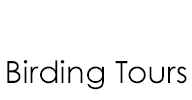December 5-14, 2024 with Marcelo Barreiros
Trinidad and Tobago is perhaps the best introductory tour for birds in South America, with a great number of families found on the continent present on both islands. It's very interesting to see how Trinidad has lots of birds from South America and Tobago Island has species from the Caribbean region, even though the islands are so close together. With nice weather during the tour, we managed to visit all the bird spots and see things like Ornate Hawk-Eagle, White-tailed Nightjar, Ruddy Quail-Dove, Tufted Coquette, Red-billed Tropicbird, Trinidad Motmot and Trinidad Piping-Guan.

The fantastic Asa Wright Nature Centre is back in business after a couple of years closed, and it was great to be back where the facilities have been remodeled and the staff still do a very good job taking care of us. When they closed, the birds stopped visiting, but the feeders and gardens are back, so the birds are coming back too. We spent a few days enjoying the famous veranda with the gorgeous Tufted Coquette, Purple Honeycreeper, White Hawk, Grey-headed Kite and more. We also explored the trails to see other great birds like the male Bearded Bellbird displaying, all three Trogons (Collared, Green-backed and Guianan), Crimson-crested Woodpecker, Golden-fronted Greenlet, Cocoa Woodcreeper, Golden-headed Manakin and Gray-throated Leaftosser.
Still in Trinidad, we did the Blachisseuese road to the north, where we saw Blue-headed Parrot, a pair of Ornate Hawk-Eagles, Red-rumped Woodpecker, a nice White-bellied Antbird, Chestnut Woodpecker, Stripe-breasted Spinetail, Great Antshrike, and Green Kingfisher. In the lowlands, we also did a good job looking for rare birds in Trinidad like the endemic Trinidad Euphonia, Green-and-rufous Kingfisher, Rufous Crab Hawk, Scrub Greenlet, Long-winged Harrier, Ruby-topaz Hummingbird, Green-throated Mango, and Pearl Kite. One of the highlights for Trinidad is the majestic Caroni Swamp, with lots of American Flamingos, Straight-billed Woodcreeper, and thousands of Scarlet Ibis coming to roost. We had a chance to have dinner watching the birds coming to roost.

After great days in Trinidad, we flew to the tourist island of Tobago, the Caribbean part of the country, land of beautiful beaches and more birds for the group. We arrived and went straight to birding near the airport, where we had Red-crowned Woodpecker, Black-faced Grassquit, White-cheeked Pintail and Green-winged Teal. On the way to our hotel, we made a very nice stop at Hummingbird House and their nice feeders, where we had fantastic looks at Ruby-topaz Hummingbird, Black-throated Mango, the rare White-tailed Sabrewing, and a Merlin chasing hummers by the feeders. The next morning was the day to visit the Main Ridge Forest Reserve, maybe the best place for birding in the forest in Tobago and it was very productive. In a few hundred meters, we had the endemic Trinidad Motmot, Violaceus Woodcreeper, Streaked Xenops, Venezuelan Flycatcher, and later along the road, we saw a few individuals of Blue-backed Manakin feeding in a fruiting tree by the road. The weather was not so great and it rained for almost two hours, so we decided to go straight to Shurland James's Hummingbird Heaven where the owner keeps fruit feeders and the incredible Trinidad Motmot is coming. After a nice local lunch, we drove back to our hotel and along the entrance road and still had time to see the Northern White-fringed Antwren. The last morning in Tobago was the day to visit Little Tobago island to see the gorgeous cliff on the other side of the island, to see both Brown and Red-footed boobies, thousands of Magnificent Frigatebird, and the gorgeous Red-billed Tropicbird.
Back in Trinidad, we spent two more nights on the eastern part of the island to see on the rarest species around, the Trinidad Piping-Guan. In our first attempt after a storm, we saw four individuals of our target bird feeding in a fruiting tree right behind the Pauwi Lodge. The birds remained feeding and resting for several minutes before disappearing into the woods. We went back in the next morning and two birds were sunning themselves in the first light. The place also has hummingbird feeders where the clients have more chances to photograph the Ruby-topaz Hummingbird and a few other species. Besides those, we also saw Plain Antvireo, White-winged Becard, and White-flanked Antwren.
Some of the other critters we saw included:
1) Brown Capuchin
2) Yucatan Howler Monkey
3) Yucatan Spider Monkey
4) Jaguar
5) Black-tailed Indigo Snake
6) Red-tailed Boa
7) Striped Basilisk
8) Common House Gecko
9) Rose-bellied Lizard
10) Green Iguana
11) Black Spiny-tailed Iguana
12) Tayra
13) White-nosed Coati
14) Paca
You can see my complete trip report on eBird at this link: https://ebird.org/tripreport/348965
You can download a combined PDF of this page and the eBird report at this link: https://fieldguides.com/triplists/tri24TRIPLIST.pdf
- - Marcelo Barreiros
